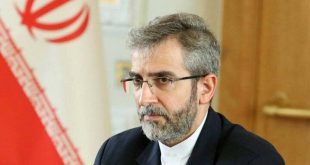Iran has started making components for machines used to enrich uranium at a new workshop in Natanz, the UN atomic agency said in a report cited by Reuters Thursday.
The British news agency claimed that the new workshop raises questions about Iran’s plans for the manufacturing of advanced centrifuges – machines that produce enriched uranium much faster than the first-generation machines it was restricted to using for that purpose by its 2015 deal with major powers.
It is now enriching with hundreds of advanced centrifuges, some of them enriching to a purity of up to 60%, it said. “That is far above the 3.67% cap imposed by the deal and the 20% it had achieved before the deal,” Reuters said.
In its confidential report to member states the International Atomic Energy Agency (IAEA) said it had finished installing surveillance cameras at the location on April 12 and had then removed the seals from the machines, the news agency said, without saying how it was privy to the confidential report.
In the past, Iranian officials have repeatedly complained to the IAEA about the leak of its confidential reports to Western news outlets. They say some of those reports have been used by Iran’s enemies against the country’s national security.
In its report, Reuters said the workshop’s precise location is of particular interest to Western powers and the occupying regime of Israel because Karaj was struck by what Tehran says was a sabotage attack by the Zionist regime. Tehran has since been seeking to ensure greater security for such sites, it added.
The Natanz site includes a commercial-scale enrichment plant that is underground, which could offer protection from any potential airstrikes.
“On 13 April 2022, Iran informed the Agency that the machines would start operating at the new workshop the same day,” the report said.
Before moving the Karaj parts to Natanz, Iran had also told the IAEA it was moving the Karaj workshop’s activities to another site at Isfahan, and the IAEA has set up cameras there.
On Thursday, Iran’s acting ambassador to the IAEA stressed that the agency will have no access to data recorded by its surveillance cameras until the 2015 deal, known as the Joint Comprehensive Plan of Action (JCPOA), is fully restored.
Muhammad Reza Ghaebi said the IAEA report was only a technical update presented by the agency’s director general on monitoring the implementation of the JCPOA, in accordance with UN Security Council Resolution 2231.
“If Isfahan went into operation, that would be a big increase in Iran’s capacity to produce advanced centrifuge parts,” Reuters said.
“This important and strategic measure, which was taken by the Islamic Republic amid negotiations aimed at the removal of oppressive sanctions, should be judged as a decisive step towards increasing the safety and security factor of Iran’s nuclear facilities and their related industries,” said Nour News which is affiliated to Iran’s Supreme National Security Council.
The website touched on the IAEA’s failure to protect Iran’s sensitive data, as a result of which “some malign activities, for which the Zionist regime has implicitly accepted responsibility, have afflicted some damage to our country’s nuclear facilities”.
“Although these activities have never impacted the progress of Iran’s peaceful nuclear program, given the sensitivity that is inherent to the nature of nuclear work, the adoption of new strategies in the structural, hardware, and software aspects has found a place on the agenda of Iran’s nuclear energy authorities so that the security of nuclear facilities can completely be ensured,” it added.
Nour News touched on an abortive bid last year to damage rotor and bellows production workshop at the TESA Karaj Complex, saying the transfer of the machines to Natanz is aimed increasing the security factor and optimizing manufacture of centrifuges.
According to the website, the machines “were activated in a remarkably fast and rigorous process after the transfer, and began manufacturing centrifuge parts on Thursday”.
“This valuable step taken by the AEOI (Atomic Energy Organization of Iran) conveys a decisive and clear message to the adversaries and those who devise malign measures against Iran’s peaceful nuclear activities, and serves to both display the agility and resourcefulness of the country’s nuclear experts in reaction to hard and soft threats, and exemplify a clear rendition of the strategy announced by Leader of the Islamic Revolution Ayatollah Seyyed Ali Khamenei, who has invariably insisted that the country’s activities and plans should not be tied to negotiations with foreign parties,” it added.

 صراط عشق صراط عشق
صراط عشق صراط عشق



